
Secret of Mana, originally released in Japan as Seiken Densetsu 2, is a 1993 action role-playing game developed and published by Square for the Super Nintendo Entertainment System. It is the sequel to the 1991 game Seiken Densetsu, released in North America as Final Fantasy Adventure and in Europe as Mystic Quest, and it was the first Seiken Densetsu title to be marketed as part of the Mana series rather than the Final Fantasy series. Set in a high fantasy universe, the game follows three heroes as they attempt to prevent an empire from conquering the world with the power of an ancient flying fortress.

Hiroki Kikuta is a Japanese composer and game designer. His major works are Secret of Mana, Trials of Mana, Soukaigi, and Koudelka, for which he also acted as producer and concept designer. He has composed music for seven other games, and worked as a concept designer in addition to composer for the unreleased MMORPG Chou Bukyo Taisen. He became interested in music at an early age, but earned a degree in Religious Studies, Philosophy, and Cultural Anthropology from Kansai University. He spent the next few years working first as a manga illustrator, then as a composer for anime series, before coming to work for Square in 1991.
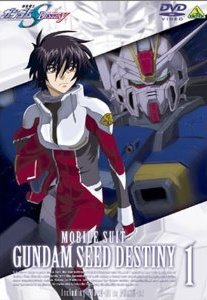
Mobile Suit Gundam SEED Destiny is an anime television series, a direct sequel to Mobile Suit Gundam SEED by Sunrise and the overall tenth installment in the Gundam franchise. It retains most of the staff from Gundam SEED, including Director Mitsuo Fukuda. Set two years after the original Mobile Suit Gundam SEED, the plot follows the new character Shinn Asuka, a soldier from the Zodiac Alliance of Freedom Treaty, or ZAFT, composed of humans born genetically enhanced labelled as Coordinators. As ZAFT is about to enter into another war against the regular human race, the Naturals, the series focuses on Shinn's as well as various returning characters' involvement in the war. The series spanned 50 episodes, aired in Japan from October 2004 to October 2005, on the Japan News Network television stations Tokyo Broadcasting System and Manichi Broadcasting System.
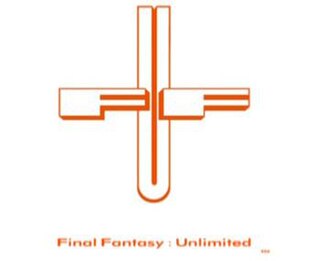
Final Fantasy: Unlimited (FF:U) is an anime television series based on Square Enix's popular Final Fantasy role-playing video game franchise. Produced by Gonzo, avex mode, TV Tokyo, Dentsu and GDH, the series was directed by Mahiro Maeda, with Atsuhiro Tomioka writing the scripts, Kazuto Nakazawa and Camel 7 designing the characters and Shirō Hamaguchi and Akifumi Tada composing the music. The TV series incorporates both 2D animation and 3D graphics, and takes elements from the Final Fantasy games. It was licensed for North America and the United Kingdom by ADV Films were released on Blu-ray. Square Enix game designer Akitoshi Kawazu served as base concept planning and was intended to be the director for the planned video game series.
Kenji Ito, also known by the nickname Itoken (イトケン), is a Japanese video game composer and musician. He is best known for his work on the Mana and SaGa series, though he has worked on over 30 video games throughout his career as well as composed or arranged music for over 15 other albums, concerts, and plays. He learned to play several instruments at a young age, and joined Square directly out of college as a composer in 1990 at the advice of a professor. He worked there for over a decade, composing many of his best-known scores. In 2001, he left Square to become a freelance composer, but has since continued to collaborate with the company.

Ogre Battle: The March of the Black Queen is a 1993 real-time tactical role-playing game developed by Quest Corporation. Originally published for Super NES by Quest in Japan and by Enix America in North America. It is the first installment of the Ogre Battle series. It was directed by Yasumi Matsuno, and designed by Matsuno with Akihiko Yoshida. The story of Ogre Battle focuses on a band of rebels as they lead a revolution against a corrupt reigning Empire, ruled by an evil Empress.

Legend of Mana is a 1999 action role-playing game developed and published by Square for the PlayStation. It was the fourth game released in the Mana series, following 1995's Trials of Mana. Set in a high fantasy universe, the game follows an unnamed hero as they restore the land of Fa'Diel by creating the world around them and completing a number of interrelated quests in order to restore the Tree of Mana.
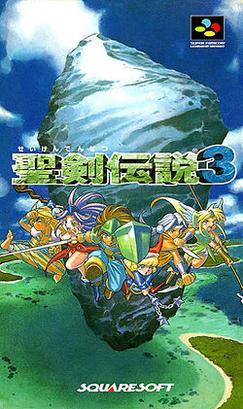
Trials of Mana, also known by its Japanese title Seiken Densetsu 3, is a 1995 action role-playing game developed and published by Square for the Super Famicom. It is the sequel to the 1993 game Secret of Mana, and is the third installment in the Mana series. Set in a high fantasy world, the game follows three heroes as they attempt to claim the legendary Mana Sword and prevent the Benevodons from being unleashed and destroying the world. It features three main plotlines and six different possible main characters, each with their own storylines, and allows two players to play simultaneously. Trials of Mana builds on the gameplay of its predecessor with multiple enhancements, including the use of a time progression system with transitions from day to night and weekday to weekday in game time, and a wide range of character classes to choose from, which provides each character with an exclusive set of skills and status progression.

Koudelka is a role-playing video game developed by Sacnoth for the PlayStation. The game was published by SNK in Japan in 1999, and by Infogrames internationally in 2000. Set in the haunted Nemeton Monastery in Wales, the plot follows protagonists Koudelka Iasant, Edward Plunkett and Bishop James O'Flaherty as they uncover Nemeton's secrets and confront monsters created from its dark past. Its gameplay blends exploration and puzzle elements with turn-based battles waged on a grid.
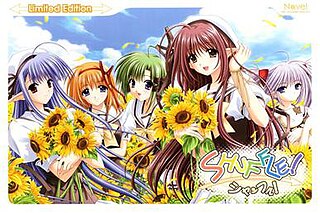
Shuffle! is a Japanese visual novel developed by Navel. It was originally released as an adult game for Windows on January 30, 2004. It was subsequently followed by an all-ages release for the PlayStation 2 (PS2) and an expanded adult release for Windows. The Windows version was localized in English by MangaGamer in 2009, and the PS2 version was localized in English by YumeHaven in 2016 on Steam. The gameplay in Shuffle! follows a branching plot line that offers pre-determined scenarios and courses of interaction and focuses on the appeal of the female main characters. Shuffle! has been re-made into an expanded version called Shuffle! Essence+. It has expanded routes for the original five main heroines and new routes for six other characters. Shuffle! also has three spin-off sequels: Tick! Tack!, Really? Really! and Shuffle! Love Rainbow.
Sacnoth Inc., renamed Nautilus Inc. in 2002, was a Japanese video game developer based in Tokyo. The company was founded in April 1997 by Hiroki Kikuta with funding from SNK; its staff, including Kikuta, were veterans of Square. While their first releases were the Dive Alert games for the Neo Geo Pocket Color (NGPC), the company was founded to produce Koudelka, a role-playing video game for the PlayStation. The development of Koudelka was troubled due to creative differences between Kikuta and the rest of the staff, with Kikuta resigning as CEO following the game's release and being replaced by Jun Mihara. The company also released the NGPC game Faselei!.
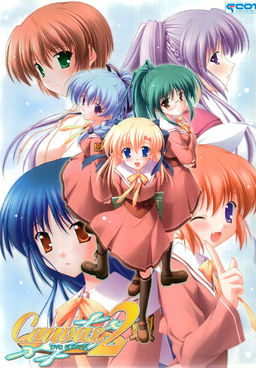
Canvas 2: Akane-iro no Palette is a Japanese adult visual novel developed by F&C FC01, a brand of F&C. The game, which is a sequel to Canvas: Sepia-iro no Motif, was released for Windows on April 23, 2004; a PlayStation 2 version without adult content was released on January 26, 2006. The story follows Hiroki Kamikura, an art teacher at Nadeshiko Academy who lost his passion for painting. Hiroki's budding relationships with the game's main heroines are the focal point of the story.
Natsuki Sumeragi is a Japanese manga artist. She graduated from Ritsumeikan University with a degree in Japanese literature. She is famous for portraying Chinese and Korean history in her works. She currently lives in Kyoto.

Junjo Romantica: Pure Romance is a Japanese boys love manga series by Shungiku Nakamura. It focuses on four storylines: the main couple, which comprises the bulk of the books, and three other male couples that provide ongoing side stories. It has expanded into several CD-dramas, a manga series running in Asuka Ciel, a light novel series titled "Junai Romantica" running in The Ruby magazine, and a 37-episode anime series.
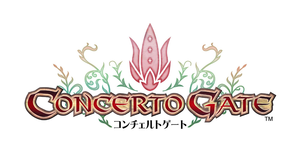
Concerto Gate is a massively multiplayer online role-playing game developed by Ponsbic and Square Enix. The game was released in Japan in 2007, and a planned North American release was cancelled after a beta release in July 2008.
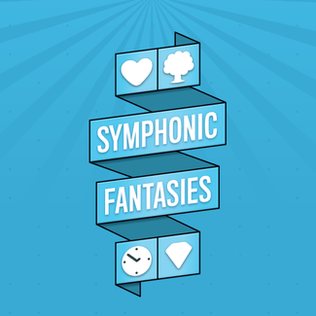
Symphonic Fantasies: Music from Square Enix was an award-winning symphonic tribute concert originally held in Cologne, Germany on September 12, 2009, at the Cologne Philharmonic Hall featuring video game music from Japanese game developer Square Enix. The concert featured symphonic movements based on the Kingdom Hearts series, Secret of Mana, the Chrono series, and the Final Fantasy series. It was produced and directed by Thomas Böcker, with arrangements provided by Finnish composer and musician Jonne Valtonen with assistance by Roger Wanamo. Due to overwhelming demand, a second concert was added at the König-Pilsener-Arena in Oberhausen, on September 11, 2009. Both performances were by the WDR Radio Orchestra Cologne and the WDR Radio Choir Cologne under conduction from Arnie Roth, with guest performers Rony Barrak and Benyamin Nuss joining the orchestra. Symphonic Fantasies was broadcast over radio on the WDR4 station and streamed live video online.
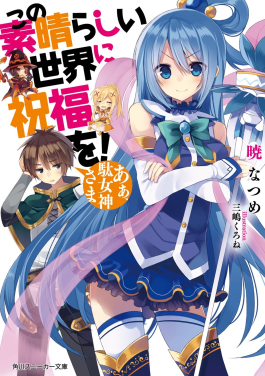
KonoSuba: God's Blessing on This Wonderful World!, often referred to simply as KonoSuba, is a Japanese light novel series written by Natsume Akatsuki and illustrated by Kurone Mishima. The series follows Kazuma Satou, a boy who is sent to a fantasy world with MMORPG elements following his death, where he forms a dysfunctional adventuring party with a goddess, an archmage, and a crusader. Originally serialized as a web novel on Shōsetsuka ni Narō between December 2012 and October 2013, KonoSuba was published as a printed light novel series by Kadokawa Shoten under the company's Kadokawa Sneaker Bunko imprint from October 2013 to May 2020. The light novel series features a divergent plot.

Shadow Hearts is a series of role-playing video games, consisting of a trilogy of titles for the PlayStation 2 (PS2) and their predecessor Koudelka for the PlayStation. The entire series was developed by Sacnoth ; Koudelka was published by SNK in 1999, while the Shadow Hearts trilogy were published by Aruze from 2001 to 2005. Multiple other publishers handled the titles overseas. The Shadow Hearts chronology extends from the late 1890s to the 1920s, following different casts of characters caught in supernatural mysteries. The setting combines alternate history and cosmic horror, with real-world figures making appearances, and each title has multiple endings.
The music of the Shadow Hearts role-playing video game series, developed by Japanese game company Sacnoth, was primarily composed by Yoshitaka Hirota. Hirota collaborated on the original game with Masaharu Iwata, Yasunori Mitsuda and Ryo Fukuda. For its sequel Shadow Hearts: Covenant, Mitsuda returned and was joined by Kenji Ito and Tomoko Kobayashi. The final game From the New World saw Fukuda and Kobayashi return with newcomer Hirotomi Imoto. The Shadow Hearts series originated in the 1999 role-playing game Koudelka, the music of which was composed by company founder Hiroki Kikuta. Each game has received a soundtrack album, with Hirota also producing an arrange album of Shadow Hearts music.

















